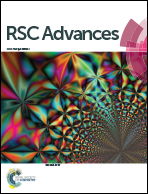Symmetrical and unsymmetrical triphenylamine based diketopyrrolopyrroles and their use as donors for solution processed bulk heterojunction organic solar cells†
Abstract
Two small molecules DPP3 (D–π–A) and DPP4 (D–π–A–π–D) with triphenylamine (TPA) donors and diketopyrrolopyrrole (DPP) acceptors linked with ethyne linkers were designed and synthesized by the Pd-catalyzed Sonogashira cross-coupling reaction. Their photonic, electronic, thermal and computational properties were investigated. The red shift in the electronic absorption spectra of DPP4 as compared to DPP3 is related to extended conjugation and increased donor–acceptor interaction. We have used DPP3 and DPP4 as electron donors along with PC71BM as an electron acceptor for solution processed bulk heterojunction organic solar cells. The solar cells prepared from DPP3:PC71BM and DPP4:PC71BM (1 : 2) processed from chloroform (CF) exhibit a power conversion efficiency (PCE) of 2.23% (Jsc = 6.74 mA cm−2, Voc = 0.92 V and FF = 0.36) and 3.05% (Jsc = 8.26 mA cm−2, Voc = 0.88 V and FF = 0.42), respectively. The higher PCE of the device with DPP4 compared to DPP3 was demonstrated as to the higher hole mobility and broader IPCE spectra. The devices based on DPP3:PC71BM and DPP4:PC71BM processed with solvent additive (1 v% DIO, 1,8-diiodooctane) showed PCE values of 4.06% and 5.31%, respectively. The device optimization results from the improvement of the balanced charge transport and better nanoscale morphology induced by the solvent additive.


 Please wait while we load your content...
Please wait while we load your content...